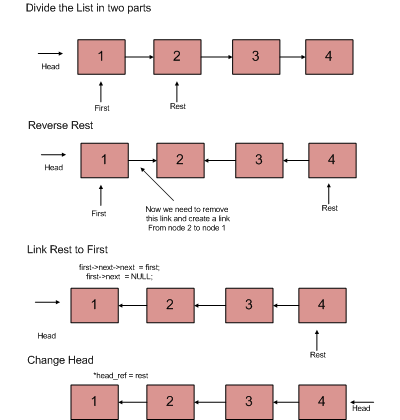206
這一題 - reverse linked list 算是經典中的經典啊,常常聽到,不過很久沒有寫也是有點忘記。我們手上有的是一個singly linked list,所以直覺上想起來,只要先產生一個vector,依序把ListNode存進這個vector,最後再從vector的最後一個element往前連,就可以得到反向的linked list了。
不過在實作過程中遭遇一個問題,感覺稍微碰觸到linked list比較不直覺的部分。就是假設我已經按照原本linked list存的順序,將每個ListNode存到vector裡,那接下來要怎麼樣init一個linked list,然後一個個把vector的element串成一個linked list?
不直覺的地方在於,我想直接把vector裡面的ListNode一個個串起來的時候,就會遭遇到自己指向自己的問題,這表示我對於linked list的操作上的直觀想法有問題:
C++ Code:
class Solution {
public:
ListNode* reverseList(ListNode* head) {
vector<ListNode*> storage;
ListNode* currentNode, reversedList;
if(head == NULL || head->next == NULL)
return head;
currentNode = head;
while(currentNode != NULL)
{
storage.push_back(currentNode);
currentNode = currentNode->next;
}
/*不直覺的地方
currentNode = storage[storage.size()-1];
for(int i=storage.size()-1; i>=0; i--)
{
currentNode->next = storage[i];
currentNode = currentNode->next;
}
*/
}
};
重新來想一下應該怎麼寫,就會發現既然會蓋掉自己,那感覺就應該要有一個tmp的ListNode來存中間的產物,結果想了一下發現根本就不用那麼複雜,還在中間存出一個vector,直接在過程中反轉就好。假設以1 -> 2 -> 3 ->4這個例子來說,一開始head指向1。那只要在trace過程中紀錄關係即可,一開始先記錄prev = head (就是1),next = prev->next (就是2),就可以開始了。
- tmp = next -> next (3)
- next - > next = prev (2->1)
- prev = next (2)
- next = tmp (3)
寫出來的code在:
/**
* Definition for singly-linked list.
* struct ListNode {
* int val;
* ListNode *next;
* ListNode(int x) : val(x), next(NULL) {}
* };
*/
class Solution {
public:
ListNode* reverseList(ListNode* head) {
if(head == NULL || head->next == NULL)
return head;
ListNode* prev;
ListNode* next;
ListNode* tmp;
prev = head;
next = prev->next;
while(next != NULL)
{
tmp = next->next;
next->next = prev; //這一行是失敗的重點
prev = next;
next = tmp;
}
return prev;
}
};
不過這份code還是有考慮得不夠的地方,每次跑起來都會超過時間限制,看起來是卡在while迴圈裡面,我用白癡debug方法,直接進while迴圈,分別在不同行後面加看看return prev,看是卡在哪一步,結果是卡在next->next = prev;這一行。
就是我反轉的時候,忘記把head->next設成NULL,一個比較好的寫法是,prev直接從NULL開始,就可以避免掉上面犯的錯誤:
/**
* Definition for singly-linked list.
* struct ListNode {
* int val;
* ListNode *next;
* ListNode(int x) : val(x), next(NULL) {}
* };
*/
class Solution {
public:
ListNode* reverseList(ListNode* head) {
if(head == NULL || head->next == NULL)
return head;
ListNode* prev;
ListNode* next;
ListNode* tmp;
prev = NULL;
next = head;
while(next != NULL)
{
tmp = next->next;
next->next = prev;
prev = next;
next = tmp;
}
return prev;
}
};
Java Code:
/**
* Definition for singly-linked list.
* public class ListNode {
* int val;
* ListNode next;
* ListNode(int x) { val = x; }
* }
*/
public class Solution {
public ListNode reverseList(ListNode head) {
/*
Concept:
1. create a new head
2. use a temp node to record head.next
3. link head node to new head
4. move new head to head
*/
ListNode newHead = null;
if(head == null || head.next == null) return head;
ListNode node = head;
while(node!=null){
ListNode tmp = node.next;
node.next = newHead;
newHead = node;
node = tmp;
}
return newHead;
}
}
Recursive 解法
Steps:
1. Divide the list in two parts - first node and rest of the linked list.
2. Call reverse for the rest of the linked list.
3. Link rest to first.
4. Fix head pointer

C++ Code:
class Solution {
public:
ListNode* reverseList(ListNode* head) {
if(head == NULL) return head; // no node in the list
ListNode* first = head;
ListNode* rest = first->next;
if(rest == NULL) return head; // only one node in the list
/* reverse the rest list and put the first element at the end */
rest = reverseList(rest);
first->next->next = first;
/* tricky step -- see the diagram */
first->next = NULL;
/* fix the head pointer */
return rest;
}
};